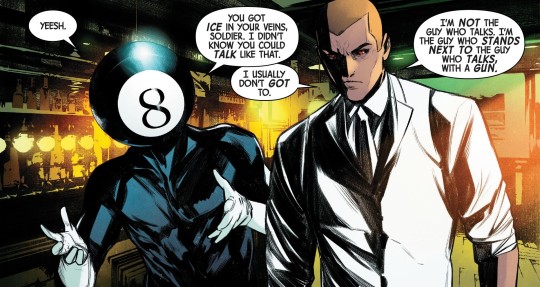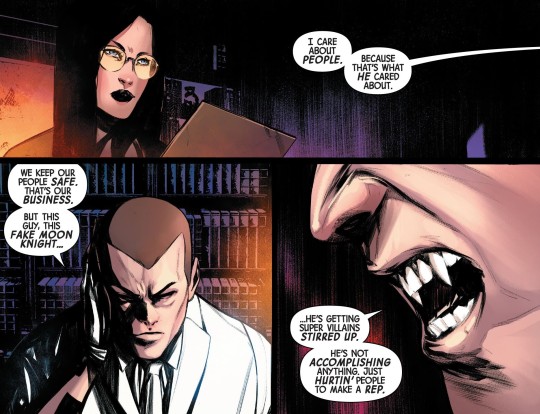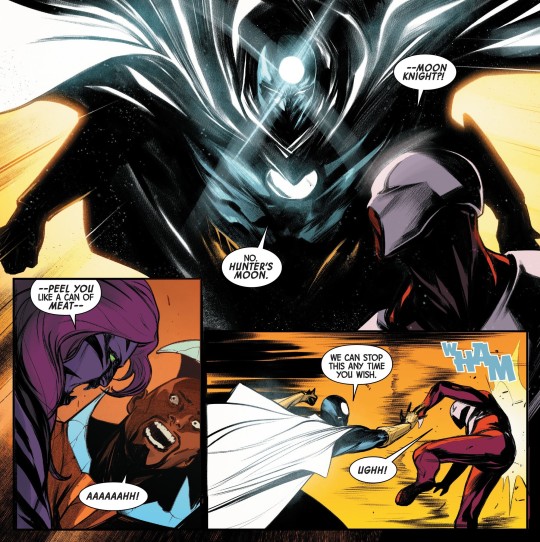#steven hudak
Text










From Vengeance of the Moon Knight Vol. 2 #003, “Soldier”
Art by Alessandro Cappuccio and Rachelle Rosenberg
Written by Jed MacKay
#vengeance of the moon knight#moon knight#soldier#8-ball#jeff hagees#andrea sterman#flying tiger#looter#norton fester#scorcher#steven hudak#squid#donald callahan#tigra#greer nelson#hunter's moon#yehya badr#lady yulan#marvel#comics#marvel comics
9 notes
·
View notes
Text
Untold Tales of Spider-Man #1 (1995) Pat Olliffe Cover & Pencils, Kurt Busiek Story, 1st Appearance of Scorcher (Steven Hudak)
#UntoldTalesofSpiderMan #1 (1995) #PatOlliffe Cover & Pencils, #KurtBusiek Story, 1st Appearance of #Scorcher (#StevenHudak) "To Serve and Protect?" #SpiderMan has finally found a new costumed criminal known as the Scorcher, who has been using his flame-throwing armor to steal experimental electronic designs from various research and development companies. SAVE ON SHIPPING COST - NOW AVAILABLE FOR LOCAL PICK UP IN DELTONA, FLORIDA https://www.rarecomicbooks.fashionablewebs.com/Spider-Man%20Comic%20Books.html#UTTS #RareComicBooks #KeyComicBooks #MarvelComics #MCU #MarvelUniverse #ComicBooks #NerdyGifts #KeyIssue

#Untold Tales of Spider-Man#pat olliffe#kurt busiek#Scorcher#Steven Hudak#key comic books#rare comics#marvel comics#spder-man
0 notes
Photo















Spider-Man Holiday Special - "A Matter of Faith" (1995)
written by Glenn Greenberg
art by Kevin Maguire, Jimmy Palmiotti, Joe Andreani, & Adam Wallenta
#spiderman#ben reilly#scorcher#steven hudak#marvel#long post#long post for ts#wilc holiday#wilc christmas
169 notes
·
View notes
Text
More Rant-Like Musings on Algorithmic Composition Software
I have recently completed a Haskell foreign function interface (FFI) to Csound, with helper functions for using Csound to render Euterpea Music values. The code is almost completely contained in Csound.hs.
In the process of writing this I have, of course, gained a better understanding of the facilities afforded by Euterpea (by Paul Hudak and others) and its offspring Kulitta and Jazzkell (by Donya Quick). In addition, while searching for other music made with Haskell, I have also learned more about TidalCycles by Alex McClean and others (for live coding music) and csound-expression by Anton Kholomiov (compose both score and orchestra in Haskell, render with Csound).
Below I list other systems that I have used or tried to use or at least examined, followed by a second list of pieces made with some of these systems. This post can in fact be used as (a highly incomplete) guide to recent algorithmic composition software. Repeating the above-mentioned systems, and in alphabetical order:
athenaCL by Christopher Ariza (Python, no longer maintained).
blue by Steven Yi (Java).
Common Music by Rick Taube (Common Lisp version, minimally maintained).
csound-expression and temporal-media by Anton Kholomiov (compose both score and orchestra in Haskell, render with Csound).
csound-extended and Silencio by Michael Gogins (JavaScript, Common Lisp, Python, Haskell, C++).
Euterpea by Donya Quick (Haskell).
Grace by Rick Taube (Scheme), the most direct descendant of Common Music.
Jazzkell by Donya Quick (Haskell).
Jeskola Buzz by Oskari Tammelin (a tracker, but you can do algorithmic composition in it using peer controllers).
Java Music Specification Language by Nick Didkovsky (Java, no longer maintained).
Kulitta by Donya Quick (Haskell).
Max by Miller Puckette and Cycling 74 (custom visual programming language).
music21 by Michael Cuthbert, Christopher Ariza, and others (Python).
nudruz by Drew Krause (Common Lisp, maintained by me, includes a Csound FFI to Common Music and OpenMusic).
Nyquist by Roger Dannenberg (XLisp).
OpenMusic by IRCAM (visual programming language based on Common Lisp).
Pure Data by Miller Puckette and others (visual programming language).
PWGL by Mikael Laurson, Mika Kuuskankare, Kilian Sprotte and others (visual programming language based on Common Lisp).
Reaktor by Native Instruments, which although primarily a user-patchable or visually programmable sound synthesizer, can also be used to compose.
RTcmix by Paul Lansky, Brad Garton, and others (C++ with custom scripting language).
Rubato Composer by Guerino Mazzola (Java, no longer seems to be maintained).
Slippery Chicken by Michael Edwards (Common Lisp, looks like another offshoot of Common Music).
SuperCollider by James McCartney and others (custom programming language).
TidalCycles by Alex McClean and others (for live coding music, Haskell).
Here I have ignored approaches to algorithmic composition based on machine learning, not because I think them unimportant, but because I don’t yet know enough about them. A starting point however would be Google’s Magenta.
I link below to some pieces that hint at the potential of some of these systems. Of course, it’s impossible to list all the best algorithmically composed pieces. My objective here is simply to focus on musical quality and originality and to present the best pieces I could easily find that were made using some of these systems.
Please note, I am primarily interested in pieces for fixed media, i.e., pieces that could be thought of as “through-composed” as opposed to “improvised.” But a lot of the action today is in improvisation, interactive pieces, and live coding.
My own example piece: Parachronic, 2018 (CsoundAC in csound-extended).
I should stop right here before even starting, and mention the pathbreaking work of Iannis Xenakis, whose works such as La Legende d’Eer and Gendy3 proved very early on that programming could be used to compose great music. Ideas from Xenakis’ software live on in many other systems.
Gendy3, Iannis Xenakis (composer software).
La Legende d’Eer, Iannis Xenakis (composer software).
Rough Raga Riffs, Brad Garton (composer software in Common Lisp, probably rendered using RTcmix).
Le lac, Tristan Murail (OpenMusic).
for rei as a doe, Michael Edwards (Slippery Chicken).
demiurgic ecstasy whispering in streets of ear, Christopher Ariza (athenaCL).
Carlisle Variations, Drew Krause (nudruz, rendered by me using Aeolus).
Tom Johnson - Algorithmic Composition, “Algorithmic Composer” (Pure Data).
Fractus 1, Eli Fieldsteel (SuperCollider)
Algorithmic Composition, “acreil” (Pure Data).
Vanishing Trajectories, Akira Takaoka (composer software and RTcmix).
Zero Waste, Nick Didkovsky (Java Music Specification Language).
Tourmaline, Donya Quick (Kulitta).
Elmas Krizi, Andrew Bergemann (Rubato Composer)
Hypnotize, Donya Quick (Jazzkell).
TidalCycles Jam 1, Eloy Platas (TidalCycles).
Jungle Etude 1, Anton Kholomiov (csound-expression).
This exercise has been exhilarating in that it discloses some hints of the amazing potential of algorithmic composition, yet somewhat depressing at the same time.
My depression arises from the fact that wonderful facilities provided by one system cannot be used by another system unless, as is actually often the case, they are re-implemented from scratch in that system. Needless to say, this is an immensely wasteful duplication of effort, and often does not quite work. Also, note the large number of systems that are no longer maintained, or are maintained by one aging composer/developer... for an even more extensive and possibly even more depressing list of software systems for composing, see Christopher Ariza’s list.
Another source of depression is the great efforts expended by many composer/developers without leaving evidence of any music that I would like to hear again.
Composers are like cats, they are impossible to herd. But in algorithmic composition, almost all of the software developers are also composers. In other fields of software development, after a decade or so, standards emerge and the resulting synergies supply a walloping jolt of power to the field. Every new feature or library in one sub-field can then be used by developers in all the other sub-fields. Examples would include the entire suite of W3C standards, the MIDI and MusicXML standards in commercial music software, and standardization on certain programs such as Pro Tools or Max in computer music. As my list sadly demonstrates, this has not happened so much in algorithmic composition software.
I call on all composers who also are software developers to do something about this. It may be too late to do anything about existing systems, but if you are contemplating developing a new system, please carefully consider my strong advice.
Update 15 October 2019: James McCartney, the developer of SuperCollider and other computer music languages, commented “No” regarding these points because he perceived them as obstructing research and personal goals. I think that his point about a continuing need for research in new music programming languages is quite valid, so I have edited my advice to reflect this. I would like to stress that my overriding concern here is to create synergies based on the the ability to use new facilities and features along with existing ones, and to avoid unnecessary duplication of effort.
Do not create a whole new system. Instead, create an extension for an existing system.
In fact, create an extension for OpenMusic, Euterpea, Pure Data, SuperCollider, or Csound.
If you do create a whole new system, do not create a whole new programming language, even if you know how. Instead, create a library or package for an existing language.
In fact, choose a widely used language such as C++, Common Lisp, JavaScript, or Python.
If you do create a whole new language because it would just be so cool, do it as a library or package for an existing system (examples would be the embedding of the Python and LuaJIT programming languages in the Csound orchestra language, or the embedding of Csound in Pure Data and Max/MSP), or provide an application programming interface that can be used to embed your new language in other applications. And that leads to...
Create your system first as a library or package, only after that as a standalone application.
Many systems have issues with the representation of music. The developer/composer often creates a representation that suits their own particular style of music but does not work well, or at all, for other styles. MIDI 1.0 as it stands is no good, but it looks like MIDI 2.0 may be better. In any event, make sure that you support arbitrary pitches, rhythms, densities of notes and sounds, tied notes, and so on. Note that Csound has a very good low-level representation of musical events.
I compiled these lists to help guide my own future work in both composition and software development.
Please notify me of any errors you find in this post, or any suggestions you have for improving it.
#music#algorithmic composition#software engineering#computer music#haskell#common lisp#javascript#csound#python
3 notes
·
View notes
Text
inspiration.
Whether it be melodies that give you inspiration for your muse, or songs that get you into the writing mood, pick 10 to 15 songs you find that give you the urge, the drive, or the creativity to write for your muse. Then tag your favorite peeps to get an insight on their musical inspirational feels!
Repost, don’t reblog please.
stephen william cornish & amanda wilson — out of my mind // allie x — all the rage // sia — chandelier // sia — alive // sia — rainbow // tara chinn — maybe I’m the monster // yodelice — talk to me // jacob miller, matt naylor, steven stern — slipping away // ben cocks — so cold // jes hudak — different worlds // lemaitre ft. jennie a. — closer // majical cloudz — downtown // ez3kiel — versus // lcd soundsystem — new york I love you but you’re bringing me down // gorillaz — clint eastwood // counting crows — colorblind // felix da housecat — silver screen // goldfrapp — lovely head // portishead — machine gun // velee — lucid dreaming // cascadeur — meaning (choral version) // todrick hall — no place like home // thirty seconds to mars — bright lights // thirty seconds to mars — do or die // odesza — line of sight // bishop briggs — river // the irrepressibles — in his shirt // shea couleé & gess — rewind // ruelle — genesis // violet chachki — bettie // violet chachki — a lot more me // violet chachki — vanguard // miley cyrus — wrecking ball // fauve — les hautes lumières
Stolen from: @warringpeace 😇
Tagging: anyone who wants to do this!
0 notes
Text
Marijuana legalization moves ahead, but plenty of bumps slow effort
Since Colorado legalized recreational marijuana in 2012, seven other states and the District of Columbia have followed suit. Next year, California, Maine, and Massachusetts will begin sales, potentially tripling the size of the legal pot market.
By the end of 2018, 20 percent of Americans will live in a state where adults can legally buy and sell cannabis. Yet big problems remain unresolved, including a persistent black market that legalization was supposed to help undermine.
There are also fights between states in favor of legalizing weed and localities that oppose it. And of course marijuana remains illegal under federal law, casting a shadow over the industry.
Related Articles

Simi Valley council extends ban on outdoor cultivation of marijuana plants, deliveries, more

Marin County medical cannabis delivery ordinance takes shape

Alameda officials consider ban on recreational use of cannabis in city

Big investment infusion planned for cannabis dispensary chain with outlets in Southern California

Confusion coming with California’s legal marijuana
aside.wpf_related.inset-links.right {float:right;clear:right;}State tax revenue from marijuana sales exceeds $1 billion. California alone anticipates another $1 billion in annual tax revenue from legalization. But with an impending January 2018 deadline to begin issuing permits, there are signs that growers and retailers may not join the state-regulated system.
Hezekiah Allen, executive director of the California Growers Association, estimates that just 3,500 of 40,000 farmers have signed up for permits but says that’s primarily because local governments haven’t issued them or have banned marijuana businesses outright.
This creates problems for state regulators.
“We have to work with over 500 different cities and counties over the state,” says Lori Ajax, chief of California’s Bureau of Cannabis Control. “For us to issue a license, we have to make sure it’s not in violation of a city or county ordinance, and because of our size, that’s a challenge.”
California grows 13.5 million pounds of marijuana annually; less than 20 percent of it is consumed there. Growers may have to downsize as new rules ban out-of-state exports. If California’s markets open in January and many existing growers are left out, tax revenue could fall short, and a robust black market will persist.
To become legal, marijuana businesses have to secure building permits and water rights and establish record-keeping protocols unfamiliar to an industry that’s long operated in the shadows.
Don’t miss our reviews of strains, vape oils and other cannabis products.
“It’s going to take decades for California to regulate its cannabis industry,” says Allen. “It’s been decades that we’ve been making this mess, and it’s going to take us a while to clean it up.”
In Maine, where a legalization ballot measure passed in 2016 by less than 1 percentage point, localities retain broad power to ban marijuana cultivators and retailers, potentially hindering the growth of the state’s cannabis industry.
Massachusetts has a July 2018 deadline to issue its permits. That’s already been delayed once. In July state lawmakers established the independent Cannabis Control Commission to develop regulations. Even with the extension, the commission’s chairman, Steven Hoffman, says the July deadline is “a pretty tight time frame.”
Early difficulties are common for recreational marijuana. Nevada faced product shortages when its markets opened in July 2017. Alaska’s first year brought in $1.2 million in tax revenue, short of a projected $2 million.
Colorado and Washington both took in less tax revenue than expected in their first year, but revenue has grown every year since and now exceeds projections. Colorado’s effective tax rate is around 30 percent, and Washington has a flat rate of 37 percent.
Joseph Bishop-Henchman of the Tax Foundation says these relatively high taxes have allowed a significant black market to persist by making legal pot expensive. States that have legalized more recently have set the rate lower. In Oregon, it’s 17 percent. Maine and Massachusetts have proposed rates of about 20 percent, while California is planning for a 15 percent levy.
There isn’t enough data to measure the impact of lower taxes, but Maine state Senator Teresa Pierce believes that Maine will “hit a sweet spot” and be able to undercut black market prices.
Special report: Cannabis & fitness
As momentum behind legalization grows, a federal crackdown appears less likely. To avoid prosecution under federal law, state legislatures adhere to the 2013 Cole Memorandum, a document issued during Eric Holder’s tenure as U.S. attorney general essentially assuring states that the feds won’t intervene as long as they follow their own rules. But the Cole Memo isn’t legally binding, and Attorney General Jeff Sessions has a long history of opposition to marijuana.
“I think the Justice Department may rearrange the deck chairs a little bit, but ultimately, they’re not going to change direction too much,” says John Hudak, a senior fellow at the Brookings Institution. “It seems like a not-so-popular approach to an issue that most Americans don’t see as a problem.”
Marijuana’s ambiguous legal standing limits the ability of businesses to operate normally. Major banks are still unwilling to service growers and dispensaries. Marijuana companies are also ineligible for common tax deductions.
This August, New Jersey Senator Cory Booker introduced a bill that would remove marijuana from the Controlled Substances Act, legalize it federally, and withhold prison funding from states with racial and class disparities in their marijuana arrest rates. With Republicans in charge of Congress, the bill is largely symbolic. That leaves states that have legalized pot trying not to attract undue attention from a potentially adversarial Trump administration.
“I think as long as we keep our noses clean, we’ll be good,” says Republican Washington state Senator Ann Rivers.
To subscribe to The Cannifornian’s email newsletter, click here.
The post Marijuana legalization moves ahead, but plenty of bumps slow effort appeared first on The Cannifornian.
The post Marijuana legalization moves ahead, but plenty of bumps slow effort appeared first on Cannabis for Chronic Pain.
source https://canna-base.com/marijuana-legalization-moves-ahead-but-plenty-of-bumps-slow-effort/
1 note
·
View note
Text
Marks Simhan TX
New Post has been published on https://nerret.com/netmyname/marks-simhan/marks-simhan-tx/
Marks Simhan TX
Marks Simhan TX Top Web Results.
www.nytimes.com A Gunman's Rampage in Texas Leaves Its Mark on a Republican …
Mar 13, 2018 … WASHINGTON — On the Sunday after a gunman killed 26 people at a church in
his home state of Texas, Senator John Cornyn, the No.
www.allmenus.com Mark's Texas Hots menu – Rochester NY 14607 – (585) 473-1563
Restaurant menu, map for Mark's Texas Hots located in 14607, Rochester NY,
487 Monroe Ave.
www.theguardian.com Texas executes 9/11 'revenge' killer | World news | The Guardian
Jul 21, 2011 … Mark Stroman shot dead two convenience store workers he believed to be Arab
in Dallas shooting spree in 2001.
www.yelp.com Mark's Texas Hots – 51 Photos & 76 Reviews – Diners – 487 Monroe …
76 reviews of Mark's Texas Hots "im from out of town and came here with two of
my friends (one who was born and raised in Rochester.) he had suggested we …
www.ncbi.nlm.nih.gov Maternal vitamin D status, prolonged labor, and cesarean and …
Aug 7, 2014 … For all analyses, we used Stata 12 (StataCorp, College Station, TX). ….. Dr. Mark
A. Klebanoff, Departments of Pediatrics and of Obstetrics and … Dr. Hyagriv N.
Simhan, Department of Obstetrics and Gynecology, School of …
www.ti.com Packaging Part Marking Lookup | Texas Instruments
Find TI product information based on semiconductor package top markings.
Search by actual marking on a TI part, or by a TI part number.
www.ncbi.nlm.nih.gov Does information available at admission for delivery improve …
Oct 7, 2009 … William A. Grobman, MD, MBA,a Yinglei Lai, PhD,b Mark B. Landon, MD,c …
Michael W. Varner, MD,g Atef H. Moawad, MD,h Hyagriv N. Simhan, …..
University of Texas Southwestern Medical Center — S. Bloom, D. Bradford.
en.wikipedia.org La Marque, Texas – Wikipedia
La Marque is a city south of Houston, Texas. The city population in 2010 was
14,509. It is a part … Madam St. Ambrose, a French Catholic Ursuline Sister and
postmistress, chose the new name, which in French means "the mark.".
academic.oup.com Maternal Serum 25-Hydroxyvitamin D and Measures of Newborn …
Mark A. Klebanoff …. We conducted analysis with STATA 12.0 (StataCorp,
College Station, TX). …… Simhan. HN. 2010. Maternal serum 25-hydroxyvitamin
D concentrations are associated with small-for-gestational age births in white
women.
tau.amegroups.com Bladder neck contracture – Simhan – Translational Andrology and …
Jay Simhan1, Daniel Ramirez1, Steven J. Hudak2, Allen F. Morey1. 1
Department of Urology, UT Southwestern, Dallas, TX, USA ; 2 Urology Section,
Department of Surgery, San Antonio ….. [PubMed]; Marks LB, Carroll PR, Dugan
TC, et al.
0 notes
Text
Marks Simhan TX
New Post has been published on https://nerret.com/netmyname/marks-simhan/marks-simhan-tx/
Marks Simhan TX
Marks Simhan TX Top Web Results.
www.nytimes.com A Gunman's Rampage in Texas Leaves Its Mark on a Republican …
Mar 13, 2018 … WASHINGTON — On the Sunday after a gunman killed 26 people at a church in
his home state of Texas, Senator John Cornyn, the No.
www.allmenus.com Mark's Texas Hots menu – Rochester NY 14607 – (585) 473-1563
Restaurant menu, map for Mark's Texas Hots located in 14607, Rochester NY,
487 Monroe Ave.
www.theguardian.com Texas executes 9/11 'revenge' killer | World news | The Guardian
Jul 21, 2011 … Mark Stroman shot dead two convenience store workers he believed to be Arab
in Dallas shooting spree in 2001.
www.yelp.com Mark's Texas Hots – 51 Photos & 76 Reviews – Diners – 487 Monroe …
76 reviews of Mark's Texas Hots "im from out of town and came here with two of
my friends (one who was born and raised in Rochester.) he had suggested we …
www.ncbi.nlm.nih.gov Maternal vitamin D status, prolonged labor, and cesarean and …
Aug 7, 2014 … For all analyses, we used Stata 12 (StataCorp, College Station, TX). ….. Dr. Mark
A. Klebanoff, Departments of Pediatrics and of Obstetrics and … Dr. Hyagriv N.
Simhan, Department of Obstetrics and Gynecology, School of …
www.ti.com Packaging Part Marking Lookup | Texas Instruments
Find TI product information based on semiconductor package top markings.
Search by actual marking on a TI part, or by a TI part number.
www.ncbi.nlm.nih.gov Does information available at admission for delivery improve …
Oct 7, 2009 … William A. Grobman, MD, MBA,a Yinglei Lai, PhD,b Mark B. Landon, MD,c …
Michael W. Varner, MD,g Atef H. Moawad, MD,h Hyagriv N. Simhan, …..
University of Texas Southwestern Medical Center — S. Bloom, D. Bradford.
en.wikipedia.org La Marque, Texas – Wikipedia
La Marque is a city south of Houston, Texas. The city population in 2010 was
14,509. It is a part … Madam St. Ambrose, a French Catholic Ursuline Sister and
postmistress, chose the new name, which in French means "the mark.".
academic.oup.com Maternal Serum 25-Hydroxyvitamin D and Measures of Newborn …
Mark A. Klebanoff …. We conducted analysis with STATA 12.0 (StataCorp,
College Station, TX). …… Simhan. HN. 2010. Maternal serum 25-hydroxyvitamin
D concentrations are associated with small-for-gestational age births in white
women.
tau.amegroups.com Bladder neck contracture – Simhan – Translational Andrology and …
Jay Simhan1, Daniel Ramirez1, Steven J. Hudak2, Allen F. Morey1. 1
Department of Urology, UT Southwestern, Dallas, TX, USA ; 2 Urology Section,
Department of Surgery, San Antonio ….. [PubMed]; Marks LB, Carroll PR, Dugan
TC, et al.
0 notes